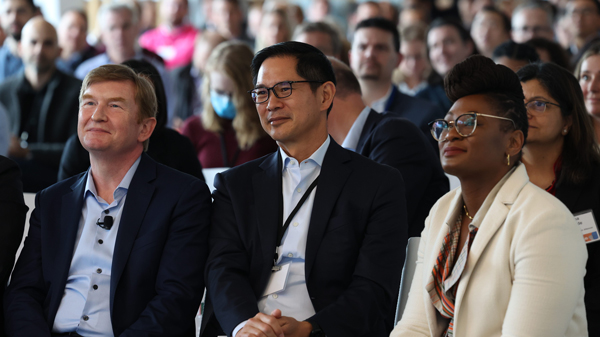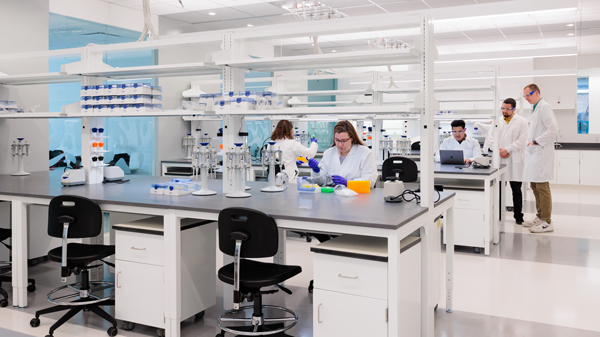Bayer’s bet on CGT: Casting a wide net for innovation

Last week, Bayer opened a new coworking space for biotech start-ups in cell and gene therapy. It’s part of an external and internal innovation push that the company hopes will position it as a leader in the emerging space.
At the launch event for Bayer’s new Co.Lab coworking space in Cambridge, Massachusetts, Stefan Oelrich, head of the company’s pharmaceutical division, made a quip about the company’s aspirations – and its current reality.
“Bayer is a household name for everyone, mainly for Aspirin,” he said. “But we’re trying to make ourselves known a little bit beyond curing headaches. In recent years, we have invested more than two and a half billion euros in the build-up of a cell and gene therapy platform, and we continue to invest in this area.”
Oelrich was talking about the company’s investment in cell and gene therapies, which he says has totalled more than €2.5 billion over the last few years. That investment includes the acquisitions of cell therapy company BlueRock Therapeutics in 2019 and gene therapy AskBio in 2020 for $240 million and $2 billion, respectively, with more paid out when certain milestones are met.

The company has made no secret of its intent to operate these companies on an “arms-length” basis to preserve the start-up culture while keeping Bayer in the loop in a high-level strategic capacity. According to Seth Ettenberg, BlueRock’s CEO, that relationship has worked wonders so far.
“There’s this sweet spot in between these two worlds where you have incredibly fast nimble decision-making very close to the data, and you understand the data because you’re involved in the creation of it, compared to the stability and commitment and long-term thinking of a big pharmaceutical company,” he told pharmaphorum in an interview at the event.
In a separate interview, Christian Rommel, Bayer’s head of research and development, echoed the same sentiment.
“The way these companies work, the way they imagine science and medicine, their creativity, the biotech environment, this doesn’t hybridise 100% with the DNA of Bayer,” he said. “It’s not a judgement of good and bad. But we thought to maintain the talent and keep the innovation going, we want to keep them independent.”
Bayer’s new Co.Lab accelerator
This brings us back to the new Co.Lab accelerator, where Bayer will invite carefully vetted start-ups, focused on cell and gene therapies, to work in a new lab space, operated by LabCentral, next door to (or rather, a floor below) the company’s own Cambridge lab. Companies will have access to lab space and mentorship from Bayer as well as access to Bayer’s manufacturing apparatus.
That last point is no small thing in cell and gene therapies (CGT), where research equipment and especially manufacturing needs are highly specialised. As LabCentral president Johannes Fruehauf mentioned in a speech at the launch event, “you can’t build these companies in your garage”.
And in return, Bayer gets… well, not much, at least on paper. There’s no equity stake and no right of first refusal for acquisition or licensing. In the name of attracting the best talent, the space and resources are offered “no strings attached” – an arrangement that’s becoming increasingly common in the competitive world of biotech-pharma partnerships.
“What we're trying to do really is develop that relationship, so to have a good understanding of the science and through the course of their incubation period to see if there is room for collaborations,” Fiona Mack, a VP at Bayer who heads up the Cambridge Co.Lab, told pharmaphorum. “And those collaborations can range from anything from licensing deals to research collaborations to investment. But it's not a prerequisite for coming into the site. We certainly want the entrepreneurs to have the flexibility to do what is business appropriate, but we also want to be able to contribute to that and ultimately become that preferred partner.”

Innovation everywhere
Underpinning all of this is the notion that innovation, especially in a wide-open emerging area like cell and gene therapy, is not necessarily going to come from within the walls of Bayer’s core business. It could come from their fully owned subsidiaries like Blue Rock, which itself came into the company via Bayer’s LEAP accelerator. Or it could come from the baby biotechs that are just starting out in Cambridge or other hotspots around the world. So, the theory goes, the best way to make sure you own the next great idea is to cast a wide net for those early-stage ideas.
“We have early academic partnerships, mid- to late-stage deals, acquisition, divestitures, out-licensing arrangements, all part of one team which handles all partnering. And the Co.Lab is really, in that sense, the new tool in that repertoire at the very early stage,” Friedemann Janus, Bayer’s head of business development and open innovation, told pharmaphorum. “And the idea is really to get access to and to foster very early innovation. These are companies at the very start of their creation, and we hope to help them to advance and accelerate their ideas by providing not only a space and lab space and state-of-the-art facilities but really a mentoring and support network to really help them with their ideas.”
The approach ends up, a bit paradoxically, both hands-on and hands-off: Hands-on in terms of the significant, proactive investment involved, but hands-off in the willingness to let start-ups be start-ups for as long as possible – even, as with the case of AskBio and BlueRock, after acquiring them.
“There certainly is a different mindset when evaluating early-stage companies,” Mack said. “There's an inherent amount of risk associated with it. But I think what we're looking for is: what can we actually guide in terms of its development? Where do we see the vision going? There are always these very broad ideas, but they can be sculpted into something that we think is going to have this disruptive effect. So that's what we're trying to get to: What's a great investable hypothesis, and then what can Bayer further help contribute to make it into a reality within that time frame of the incubation period?”
All this is not for the faint of heart in an industry that has a reputation for risk aversion and tight capital management. But if a company gets it right, the payoff could be significant: Although only a handful of cell and gene therapies have been approved by regulatory bodies today, conventional wisdom holds that the floodgates are due to open soon: The FDA could approve as many as 13 by the end of this year according to In Vivo, and the agency has said that it expects to be approving 10 to 20 a year by 2025.
Bayer is just trying to get ahead of that curve.
“Once you have this presence – you have talent and investment – then you have to start thinking, what do the next 10 or 20 years look like?” Rommel said. “We are now executing our strategy and pipeline, uniquely positioned in the industry. We have technology, science, and clinical experience, and we want to make those available to the world. We want to be differentiated. We want to be magnetic to people who have a commitment to that space.”













